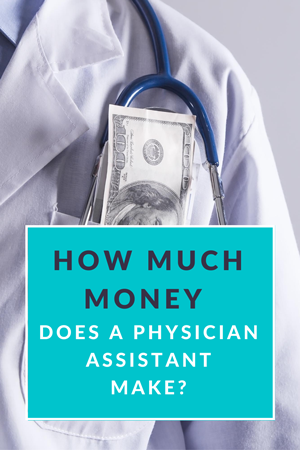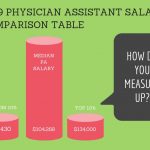Physician Assistant/Associate Salary and Compensation
"We make a living by what we get, we make a life by what we give." - Winston Churchill
 How Much Do PAs Make?
How Much Do PAs Make?
According to the latest NCCPA data, the average projected salary of certified PAs in 2024 is $120,204 per year or $57.74/hour ($117,381 in 2022), and the median projected annual salary is $115,000 per year. This is 218% of the US median salary.
A salary of $120,381 per year equates to an average physician assistant pay of $10,017/month, $2,313/week, and an hourly wage of $57.74/hr.
The highest-paid PAs are those working in dermatology ($129,246) and critical care medicine ($125,522).
According to the NCCPA data, the average total income for Certified PAs has increased by 8.7% between 2018 and 2022, and the percentage of PAs earning more than $200,000 has increased by 1.2% during that time.
On average, family medicine PAs make $105,286 per year ($50.62 per hr.), emergency medicine PAs make $125,110 per year ($60.15 per hr.), and an orthopedic surgery PA can expect to make $122,477 ($58.88 per hr.).
The Bureau of Labor Statistics (BLS) reports the median salary for PAs at $126,010/year or $60.58 per hour ($115,390 in 2022), with the top 90% earning $164,620/year or $79.14 per hour ($162,240 in 2022), an increase of 1.47% from the previous year (2.8% in 2022).
The latest American Academy of Physician Assistants (AAPA) salary report showed a slight increase in projected PA salary from previous years to $120,000 per year or $57.69 per hour in 2023 ($115,000/yr. in 2022, $111,000/yr. in 2021, and $107,500/yr. in 2020). It was the only report showing a decline in salaries in the previous year's report (2021).
As of January 2023, the average annual pay for a physician assistant in the United States, according to data from ZipRecruiter, is $120,212 a year or $58 per hour ($110,875 in 2022). While ZipRecruiter sees yearly salaries as high as $160,000 and as low as $50,500, the majority of PA salaries currently range between $103,00 (25th percentile) to $136,000 (75th percentile) across the United States.
PAs working in outpatient care centers earn the highest salaries, with a mean of $121,320. New York had the highest number of employed PAs at 13,270 and a mean wage of $123,080. Connecticut had the highest salary for PAs at $137,060. Salinas, California, was the top-paying metropolitan area with an annual salary of $161,370.
The median salary for recently certified, new-graduate, male, and female PAs is ~$95.000 per year.
PAs who receive an hourly wage rather than an annual salary earn an average of ~$60.00 per hour.
Most (79.4%) of PAs are paid an annual (versus hourly) salary. PAs who work in emergency medicine or urgent care or are independent contractors are more likely to receive an hourly wage.
Compare this to the average annual salary of a general practice physician of $227,395 or an emergency room physician of $284,561 in 2024.
Jobs Related to Physician Assistant
- Nurse Anesthetist - Average Salary $202,470
- Nurse Practitioner - Average Salary $118,040
- Physician - Average Salary $231,500
- Registered Nurse - Average Salary $82,750
Most PAs Receive Additional Non-Salary Benefits:
In addition to their base salary, most PAs receive additional non-salary benefits:
- Half of full-time clinically practicing PAs receive a bonus of $6,000 or more, with the average bonus being $6,118. Sadly, the average bonus for a female PA is $3,000 less than their male counterparts.
- Almost all (87%) of PAs receive some professional development compensation from their primary employer. These include DEA license reimbursement, CME expense coverage, reimbursement of state license fees, etc., etc.
- Most full-time PAs continue to have individual health, dental, and liability insurance included as a covered benefit.
- The majority of employers match between 3-7% of 401K contributions.
PA salaries and the buying power of those salaries vary significantly by region. While PAs in California have some of the highest median salaries of $118,000, PAs in Kentucky, Iowa, and Mississippi have some of the highest cost-adjusted median wages in the nation.
What is the Best PA Salary Report?
As you can see, there are multiple organizations that report the salary of physician assistants; however, each PA salary report varies with how the data is gathered and what salary data is included.
The NCCPA Statistical Report and AAPA salary reports combine a decent sample size (the NCCPA report wins by including ~117,280 of 131,152 certified PAs) and comprehensive data (the AAPA report includes salary by region, specialty, benefits, etc.) and are probably the most reliable.
The median projected pay for PAs in 2024, according to four of the most reliable PA salary reports, is summarized here:
- AAPA Salary Report: $120,000 per year or $57.69/hr. in 2024 ($115,000/yr. in 2022, $111,000/yr. in 2021, and $107,500/yr. in 2020)
- NCCPA Statistical Report: $120,204 per year or $57.74/hour in 2024 ($117,381 in 2022)
- The Bureau of Labor and Statistics Occupational Outlook: $126,010/year or $60.58 per hour in 2024 ($115,390 in 2022)
- ZipRecruiter PA Salary Report: $121,952 a year or $59 per hour in 2024 ($110,875 in 2022)
*Consider increasing your salary projection by up to 7-9% based on current inflation.
Like a fine wine, PA salaries also get better with age
Years of experience also matter, with salary peaking for PAs with 15-19 years of experience. Those in this group can make up to $30,000 more per year than their new-grad counterparts.
According to NCCPA data, 68% of new graduate students expect starting salaries in the $80,000 to $100,000 range. In comparison, 22.0% of recently certified PAs who have not yet accepted a position indicate that the minimum wage they would accept for their first position would be over $100,000. Of recently Certified PAs who have accepted a position, 35.0% are earning over $100,000.
PA salaries, on average, have shown a 15.7% increase over the last six years, which is about a 2.61% increase per year, which means PA salaries have historically been beating the current US inflation rate.
Top paying states for Physician Assistants (USBLS)
| State | Employment | Hourly mean wage | Annual mean wage |
|---|---|---|---|
| Rhode Island | 300 | $ 70.62 | $ 146,880 |
| Alaska | 440 | $ 70.11 | $ 145,830 |
| Connecticut | 2,670 | $ 68.17 | $ 141,790 |
| New Jersey | 3,710 | $ 67.34 | $ 140,080 |
| New Hampshire | 800 | $ 66.02 | $ 137,330 |
Best-Paying Cities for Physician Assistants
The metropolitan areas that pay the highest salary in the physician assistant profession are Portsmouth, Panama City, San Francisco, San Jose, and Vallejo. Are you looking to relocate? Here are the ten best cities for PAs to move to in 2024.
| Portsmouth, New Hampshire | $167,240 |
| Panama City, Florida | $165,000 |
| San Francisco, California | $164,150 |
| San Jose, California | $163,720 |
| Vallejo, California | $162,030 |
Physician Assistant Earnings by Part-time and Full-time Status (AAPA)
| Earnings | 10th percentile | 25th percentile | 50th percentile | 75th percentile | 90th percentile |
| Part-Time | |||||
| Base Salary | $45,000 | $60,000 | $78,000 | $95,000 | $112,000 |
| Base Hourly | $45 | $50 | $55 | $65 | $75 |
| Bonus | $600 | $1,000 | $3,000 | $10,000 | $21,000 |
| Hours Worked | 16 | 20 | 24 | 30 | 32 |
| Full Time | |||||
| Base Salary | $83,000 | $92,000 | $112,260 | $117,000 | $157,000 |
| Base Hourly | $45 | $51 | $60 | $68 | $80 |
| Bonus | $100 | $2,500 | $6,000 | $14,000 | $30,000 |
| Hours Worked | 35 | 40 | 40 | 50 | 55 |
Total income in the last calendar year from PA positions (NCCPA)
| Specialty | Salary |
| Addiction Medicine | $113,864 |
| Adolescent Medicine | $91,045 |
| Anesthesiology | $107,421 |
| Critical Care Medicine | $125,522 |
| Dermatology | $129,246 |
| Emergency Medicine | $125,110 |
| Family Medicine/General Practice | $105,286 |
| Gynecology | $98,145 |
| Hospice and Palliative Care | $106,333 |
| Hospital Medicine | $114,356 |
| Internal Medicine | $105,081 |
| Neurology | $104,933 |
| Obstetrics and Gynecology | $99,151 |
| Occupational Medicine | $111,286 |
| Ophthalmology | $100,067 |
| Otolaryngology | $105,913 |
| Pain Management | $111,938 |
| Pathology | $101,667 |
| Pediatrics | $94,526 |
| Physical Medicine/Rehabilitation | $104,150 |
| Public Health | $95,323 |
| Psychiatry | $113,417 |
| Radiation Oncology | $106,848 |
| Radiology | $113,440 |
| General Surgery | $115,427 |
| Surgery– Subspecialty | $122,477 |
| Urology | $109,532 |
| Source: NCCPA Statistical Profile of Physician Assistants |
Living Wages in All 50 States
| RANK | STATE | INCOME REQUIRED |
|---|---|---|
| 1 | Mississippi | $45,906 |
| 2 | Oklahoma | $46,024 |
| 3 | Alabama | $46,577 |
| 4 | Arkansas | $47,111 |
| 5 | Kentucky | $47,318 |
| 6 | Kansas | $47,379 |
| 7 | West Virginia | $47,732 |
| 8 | Missouri | $47,771 |
| 9 | Iowa | $48,518 |
| 12 | Tennessee | $48,774 |
| 11 | Nebraska | $49,009 |
| 10 | Georgia | $49,051 |
| 13 | Illinois | $49,372 |
| 14 | Wyoming | $49,666 |
| 15 | Indiana | $49,855 |
| 17 | Michigan | $50,049 |
| 16 | Louisiana | $50,087 |
| 18 | Ohio | $50,157 |
| 19 | Texas | $50,497 |
| 20 | New Mexico | $51,214 |
| 21 | Minnesota | $51,668 |
| 22 | South Dakota | $52,095 |
| 23 | South Carolina | $52,222 |
| 24 | North Dakota | $52,807 |
| 25 | Wisconsin | $53,122 |
| 26 | North Carolina | $53,531 |
| 27 | Pennsylvania | $53,838 |
| 28 | Utah | $55,293 |
| 29 | Delaware | $56,571 |
| 31 | Montana | $57,056 |
| 30 | Florida | $57,064 |
| 32 | Virginia | $57,293 |
| 34 | Nevada | $58,580 |
| 33 | Idaho | $58,634 |
| 35 | Colorado | $59,218 |
| 36 | Rhode Island | $59,936 |
| 37 | Arizona | $60,026 |
| 38 | Maine | $60,862 |
| 39 | New Hampshire | $62,935 |
| 40 | Connecticut | $63,078 |
| 41 | New Jersey | $64,463 |
| 42 | Washington | $65,640 |
| 43 | Oregon | $65,763 |
| 44 | Vermont | $65,923 |
| 45 | Maryland | $67,915 |
| 46 | Alaska | $71,570 |
| 47 | New York | $73,226 |
| 48 | California | $80,013 |
| 49 | Massachusetts | $87,909 |
| 50 | Hawaii | $112,411 |
Know Your Worth
The National Commission on Certification of Physician Assistants Statistical Reports
- 117,280 of 131,152 certified PA respondents
- FREE for everyone
AAPA Salary and Compensation Report
- 13,099 of 131,152 PA respondents
- FREE to AAPA fellows, students, and retired members and $200 to non-members
Included in the AAPA annual report are the following:
- Median Base Salary and Bonus from Primary Employer by Work Setting and Years of Experience
- The proportion of Professional Expenses Paid, such as DEA, NCCPA fees, AAPA membership, and CME expenses
- Insurance Benefits Paid for by Primary Employer
- Retirement Benefits Provided by Primary Employer
- Paid Days Off
- PA Call Status
- Hours per Month PAs Took Call
- PA Participation in Profit-Sharing Plans
- Mode of Profit Sharing
- Amount of Additional Forms of Compensation
- PA Compensation by Wage Type (annual, hourly, and productivity pay)
- Median PA Salary By Region (west, northwest, south, and Midwest)
- Median Base Salary from Primary Employer by Primary Work Setting
- Median Base Salary from Primary Employer by Employer Type
- Median Base Salary from Primary Employer by Major Specialty Area
- Career Changes by PAs
Also included in the AAPA report is a cost-adjusted median salary by state. Using cost-of-living data, you can determine not only your adjusted cost-of-living salary, but you can use this data to calculate the salary you will need to maintain the same standard of living in a different location.
Additional resources:
Recommended Reading:
















Leave a Reply